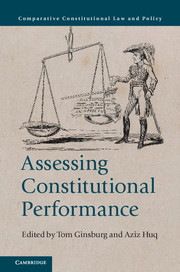Book contents
- Frontmatter
- Contents
- List of figures
- List of tables
- List of contributors
- Acknowledgments
- INTRODUCTION
- PART I DEFINING CONSTITUTIONAL PERFORMANCE
- 2 Hippocratic constitutional design
- 3 What is a good constitution? Assessing the constitutional proposal in the Icelandic experiment
- 4 When is a constitution doing well? The Alberdian test in the Americas
- 5 Parties and constitutional performance
- PART II MANAGING SPECIFIC CONSTITUTIONAL CHALLENGES
- PART III CASE STUDIES
- Index
- References
3 - What is a good constitution? Assessing the constitutional proposal in the Icelandic experiment
from PART I - DEFINING CONSTITUTIONAL PERFORMANCE
Published online by Cambridge University Press: 05 August 2016
- Frontmatter
- Contents
- List of figures
- List of tables
- List of contributors
- Acknowledgments
- INTRODUCTION
- PART I DEFINING CONSTITUTIONAL PERFORMANCE
- 2 Hippocratic constitutional design
- 3 What is a good constitution? Assessing the constitutional proposal in the Icelandic experiment
- 4 When is a constitution doing well? The Alberdian test in the Americas
- 5 Parties and constitutional performance
- PART II MANAGING SPECIFIC CONSTITUTIONAL CHALLENGES
- PART III CASE STUDIES
- Index
- References
Summary
Between 2010 and 2013 Iceland engaged in an unprecedented experiment in peacetime constitutional redrafting. The process included innovative participatory methods, including a National Forum, an elected Constitutional Assembly of non-professional politicians, and the well-known use of online crowdsourcing for twelve successive drafts of the constitutional proposal (which earned the latter its international, and perhaps overhyped, reputation as the “crowdsourced constitution”). Begun in the aftermath of a cataclysmic banking and financial crisis, which was estimated to have destroyed assets equivalent at the time to seven times the country's annual GDP, and spurred on by the new political personnel that came to power after the “Pots-and-Pans” revolution of 2008, the constitutional process ultimately led to a proposal that was approved by a two-third majority of the voters in the fall of 2012. After further amendments by legal experts, the proposal was offered to the Althingi (the Icelandic Parliament) as a bill to be discussed and voted on in the spring of 2013. To many commentators’ surprise, however, the bill was shelved at the eleventh hour for reasons that seem more political than substantive (Gylfason 2013b). The crowdsourced constitutional proposal is now considered dead by its opponents and “on ice” by its advocates (2014). It is unclear at this point whether it still stands a chance to be adopted as such in the near future.
The question that interests us here, however, is whether the crowdsourced proposal meant to replace the 1944 constitution was a good constitution – not merely in the sense of having been produced by the right kind of process but in a thicker, more substantive sense, which is entirely independent of the process that led to it. Previous work on the Icelandic experiment has focused on procedural aspects of the constitutional process. For example, in past work I argued that the Icelandic constitutional process aimed to be inclusive of the full diversity of the Icelandic people's views and to the extent that it succeeded, could be expected to have produced a substantively sound constitution, that is, a constitution tracking relevant facts and values of the Icelandic people in the twenty-first century and channeling its collective wisdom (Landemore 2015).
- Type
- Chapter
- Information
- Assessing Constitutional Performance , pp. 71 - 98Publisher: Cambridge University PressPrint publication year: 2016
References
- 4
- Cited by

